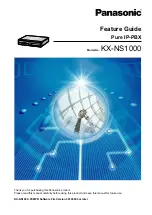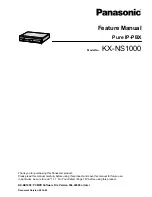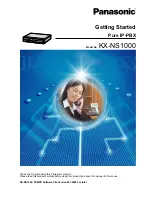
Chapter 18 Outbound Line Group
X2002 User’s Guide
275
Specific
Support
Select
None
if you do not need any of the following options:
Select
Nortel (MCS 5100/5200)
to support the specified Nortel SIP
server.
Select
Huawei
to support Huawei SIP servers.
Select
Siemens early media support
to turn on support for Seimens
early media.
Proxy Require
Enter this (0~127 alphanumeric characters) to inform the SIP server
that this device is behind a firewall or NAT device. Fill this field in only if
you were given information by your SIP service provider.
Channel-limit
Specify the maximum number of SIP calls (1~128) allowed to be made
through this trunk connection at one time.
Session Timer
Enable Session
Timer
Select this activate the X2002’s session timer. If you encounter
connectivity issues with your network or Internet, then it is suggested
that you use the session timer.
Minimum SE
Enter the minimum session expiry time in seconds. The allowable range
is 90~1800 seconds.
When an incoming call requests a session expiry time that is lower than
this, the X2002 uses this value instead.
Session Expires Enter the session expiry time in seconds for all phone connections on
this trunk The allowable range is 90~86400 seconds. This value cannot
be lower than the
Minimum SE
.
This allows the X2002 to automatically disconnect any phone calls on
this trunk after a certain period of inactivity.
CallerID Setting Configure this section to change the format of identification you want to
send when you make VoIP phone calls.
The default format is
“From: “Extension”<Extension@Server IP>”
.
CallerID Viewer This field displays the caller ID format shown to the callees depending
on the setting you configure in the
CallerID Name & Number
and
The Extension Prefix
fields.
Table 95
Configure a SIP Trunk (continued)
LABEL
DESCRIPTION
Summary of Contents for X2002
Page 2: ......
Page 24: ...Table of Contents X2002 User s Guide 24...
Page 25: ...25 PART I User s Guide...
Page 26: ...26...
Page 40: ...Chapter 2 How It Works X2002 User s Guide 40...
Page 99: ...99 PART II Technical Reference...
Page 100: ...100...
Page 124: ...Chapter 5 Network Deployment X2002 User s Guide 124...
Page 166: ...Chapter 7 Auto Provision X2002 User s Guide 166...
Page 170: ...Chapter 8 QoS X2002 User s Guide 170...
Page 248: ...Chapter 16 Click To Talk Group X2002 User s Guide 248...
Page 252: ...Chapter 17 Group Access Code X2002 User s Guide 252...
Page 304: ...Chapter 19 Auto Attendant X2002 User s Guide 304...
Page 312: ...Chapter 20 LCR X2002 User s Guide 312...
Page 346: ...Chapter 22 Call Services X2002 User s Guide 346...
Page 380: ...Chapter 25 Status Observation X2002 User s Guide 380...
Page 402: ...Chapter 27 Call Detail Record CDR X2002 User s Guide 402...
Page 410: ...Chapter 28 ACD Logs X2002 User s Guide 410...
Page 416: ...Chapter 29 Administrator Accounts X2002 User s Guide 416...
Page 424: ...Chapter 30 Diagnostics X2002 User s Guide 424...
Page 426: ...Chapter 31 X2002 User s Guide 426...
Page 446: ...Chapter 32 Remote Management X2002 User s Guide 446...
Page 448: ...Chapter 33 TFTP Management X2002 User s Guide 448...
Page 462: ...Chapter 35 License Control X2002 User s Guide 462...
Page 482: ...Chapter 36 Web Portal X2002 User s Guide 482...
Page 508: ...Chapter 39 Product Specifications X2002 User s Guide 508...
Page 548: ...Appendix C Legal Information X2002 User s Guide 548...
Page 562: ...Index X2002 User s Guide 562...




































